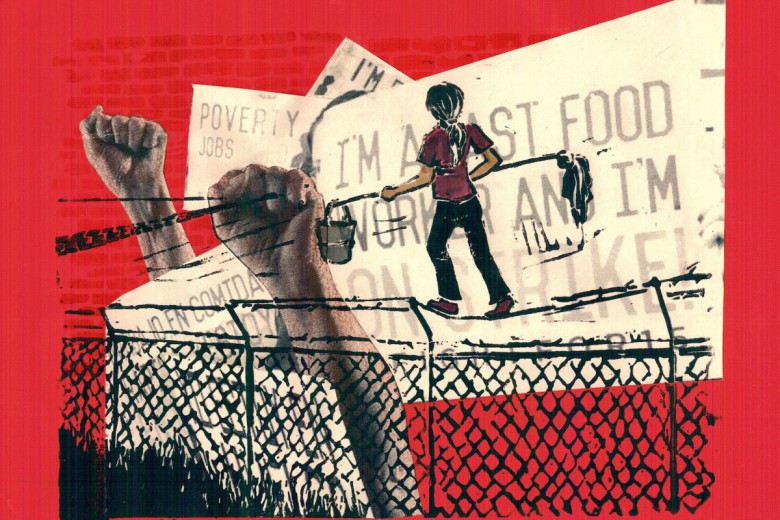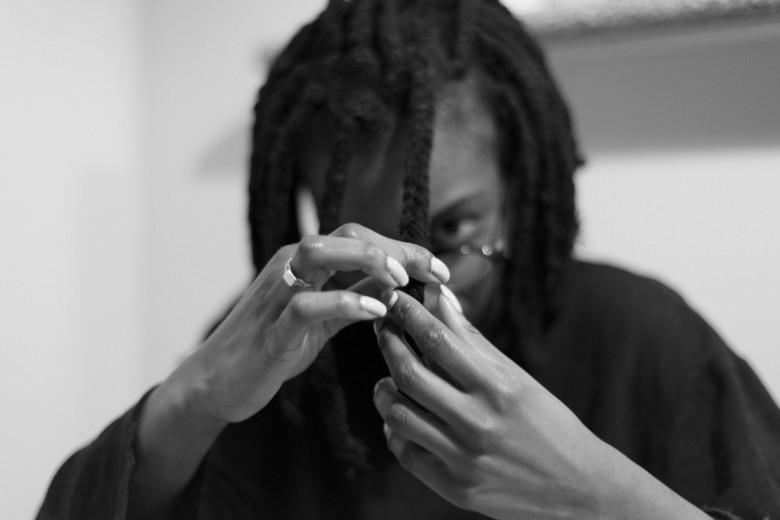
It’s the last day of the week-long Living Buddhism class I’ve been attending at Wat Songdhamma Kalayani, an all-female temple in Nakhon Pathom, Thailand. After our morning chants and prayers, we have set off on an alms round with nuns and novitiates from the temple. We make our way from the temple grounds into the surrounding community, where groups of people are waiting along the street and in front of their homes to donate food and other supplies to the nuns.
We walk quietly, in single file. It is still early in the morning and the air doesn’t have the oppressive humidity to which I have grown accustomed. We see male monks in their saffron robes down the street from us, also making their daily alms rounds.
When a man kneels reverentially in front of the young female nun leading the prayers, I finally understand the religious clergy’s resistance to ordination of Bhikkhunis (the highest order of Buddhist nuns) in Thailand. In a country where even the King defers to monks, the implications of allowing women to inhabit the same spiritual plane as men would have a profound effect on a country that is still bound by ancient traditions.
There is a glass ceiling for women seeking spiritual advancement in the Buddhist temples, or “wats” that dot the Thai landscape. Women who seek to be ordained as Bhikkhunis, the highest order of Buddhist nuns, possessing equal status to monks, continue to experience significant resistance from the religious clergy and more conservative elements of Thai society.
In this country of over 300,000 monastics, Dr. Chatsumarn Kabilsingh, whose ordained name is Dhammananda Bhikkhuni, is a trailblazer in the movement to create a Bhikkhuni order in Thailand. She is the Abbess of Wat Songdhamma Kalayani, about a half-hour’s drive from the outskirts of Bangkok, in the ancient city of Nakhon Pathom.
Woman seeking sangha
I became familiar with Dhammananda and the barriers facing female monastics in Thailand in an accidental, tourist kind of way. In the midst of what might be termed an existential crisis, triggered by the worst economic crisis in decades, a year-long dry spell in freelance work and some personal setbacks, I found myself increasingly drawn to learn more about Buddhism, with its focus on the self as a starting point for all change — not unlike the famous quote by Mahatma Gandhi, “You must be the change you wish to see in the world.”
I had read a few books on Buddhism, but found myself wanting to find a sangha, or spiritual community, where I could deepen my understanding of the theory and practice of Buddhism through formal practice. I had naively assumed that finding a Buddhist monastery to stay at for a few weeks or a month would be a somewhat simple proposition — according to the articles and online posts I had read, western men who sought to learn more about Buddhism seemed to have no trouble finding a monastery where they could receive daily teachings from monks or lamas. But to my dismay, I discovered that temples with female abbesses and novitiates (nuns in training) are practically non-existent in Southeast Asia.
After some searching, I learned of Wat Songdhamma Kalayani. They were holding a “living Buddhism” class starting in a few weeks that was described on their website as a “program designed for non-Buddhist, English-speaking international visitors who would like to learn about the basic concept of Buddhism, living in a monastic setting at the only Thai female monastery.” Participants were asked to wear white and observe the eight precepts: no killing, stealing, sex, lying, intoxicants, eating after noon (they relaxed this for westerners), entertainment or high beds.
Our daily schedule included an hour and a half of chanting and meditation each morning and evening, four hours of lectures, handicrafts hour (in which we learned origami, the ancient Japanese art of paper folding and other crafts to promote mindfulness), and “community time” in the evening, which often involved weeding in the garden.
I arrived at the monastery during Sunday prayers. The temple is located off a busy, six-lane highway. Visitors are greeted by a large, gold, laughing Buddha statue that is visible from the highway. I was taken up to the second floor of the temple to meet the Venerable Dhammananda, a tall woman in her early 60s with a shaved head, wearing orange robes. Novitiates and locals (men and women) were sitting on the floor while Dhammananda led the prayers and chanting in Thai. The other three individuals who had registered for the Living Buddhism class — a woman from New Zealand who lives in Bangkok with her husband, a Belgian woman who had been attending the monastery for a few years now and a Thai doctor from Chiang Mai who led our nightly meditation sessions, wouldn’t arrive until the following day.
Culture clash
Most Buddhists in Thailand practice Theravada Buddhism. This is the most conservative form of Buddhism, dedicated to preserving the teachings and practice of the Buddha in their original form. Thais believe they are accumulating merit — which will allow them to be reborn in better circumstances — by giving donations to support the monasteries and build new temples. Nearly all Thai men spend a few months in temporary ordination at a Thai temple at some point in their lives.
The social prestige of the monastic life has begun to fade, however. Many of the seminarians I met encountered the disapproval of their families when they expressed an interest in ordination. For instance, the mother of a nun I met who had recently graduated with a BA degree had not wanted her to become a nun; she wanted her to use her degree to get a well-paying job. Another nun I met had been married; both husband and wife decided to join a temple after they retired and their children were grown. Some seminarians are trying to escape abusive situations. Many of the younger seminarians will return to lay life after a few months. One said she had a life-threatening medical condition that the doctors were unable to treat. She said it was only after meditating for hours every day that she started to recover. This led to her desire to join the monastery.
Living Buddhism
While Thai attitudes toward sexuality and female autonomy are quite relaxed compared to many places, cultural attitudes towards women among the country’s Buddhist clergy remain quite rigid. The traditional stance against the ordination of women has been described by one writer as an example of how “the egalitarian ideals of Buddhism appear to have been impotent in the universal ideology of masculine superiority.”
As Rochelle Jones wrote in a 2005 report for AWID, the Association for Women’s Rights in Development, “Women in Thailand are supportive of Dhammananda’s quest [for female ordination], asserting that monks do not know how to listen to women’s needs and problems in the community and are educated to avoid women. The temple of women in Nakhon Pathom gives them confidence and support from the Buddhist community they have never had before. In Thai culture, monks are not allowed to touch women, and Buddhist nuns in Thailand are given a lower rank than even the youngest monk, and are relegated to the more menial tasks in the temple, such as cleaning and cooking.”
In Thai culture, it is believed that, if you were born a man, it means you accumulated more merit in a past life than if you were born a woman. One of my classmates, who is the president and a long-time member of the Soroptimist International Club in Thailand, an international humanitarian organization that works to advance the status of women worldwide, explained to me that this is why poverty-stricken families will allow their daughters to become sex workers if it means that the sons can continue on with their education.
Dhammananda is concerned about the disparity between the core teachings of Buddhism and how it is practiced by the lay population. There is more public emphasis on the rituals of Buddhism, such as accumulating merit by giving money and alms to the temples, and less on understanding the more complicated notion of dukkha (suffering) and how to achieve Nibbana or Nirvana (enlightenment).
She took us to another temple in Nakhon Pathom to see for ourselves. The scene was a buzz of activity with families milling around. There were many opportunities to give offerings with incense and perform other merit-bearing activities, but it didn’t feel particularly spiritual to me. This was a real-life example of the intersection of Buddhism as a spiritual ideal and Buddhism as practiced in a living, breathing society.
My Belgian classmate has been going to the monastery for a number of years now. She is a physical therapist who, in her spare time, is researching the role of women in Buddhism. She first met Dhammananda in 2003 after the Abbess was fully ordained in Sri Lanka, and travelled with her throughout Thailand. During that time the Abbess encountered much hostility and received death threats. Dhammananda was the first Thai woman to be ordained in the Theravada monastic lineage, but her title is not recognized by Thailand’s religious authorities. She continues to experience open hostility from lay men and monks who believe that female monastics are illegal and corrupt.
Dhammananda’s mother and grandmother were both strong advocates for female ordination. Her grandmother was instrumental in the creation of a female order of monks in the 1920s, though King Rama V banned the practice in 1928, and her mother became the first Thai Bhikkhuni since ancient times when she was ordained in Taiwan in 1974 in the Mahayana Buddhist tradition, an ordination that was not recognized by the Thai religious establishment.
In 2005, the initiative 1,000 Women for the Nobel Peace Prize 2005 included Dhammananda among their list of nominees for the prestigious prize. She has two grown sons and is also a grandmother. She received her PhD in Buddhist studies from Maghda University in India and taught Buddhist philosophy at Maha Chula Sangha University and Thammasat University in Bangkok for many years prior to becoming the Abbess of the temple that her mother founded. She has also authored a number of books on Buddhism. In Dhammananda’s past life, she hosted a popular television talk show for many years called Life is Not Without Hope. After she decided to ordain, she filed for divorce from her husband. In a 2003 interview with Buddhadharma magazine she recalled, “I told my husband that I wanted to follow my path, that I wanted to do something much more meaningful than sit at home being an old lady.”
Reality check
Sri Lanka is the only Theravada Buddhist country with a history of female ordination. The country re-established a Bhikkhuni Sangha in 1996 with assistance from Korean and Taiwanese Bhikkhunis from the Mahayana Buddhist tradition. Meanwhile, the male Supreme Sangha in Thailand continues to resist the ordination of Bhikkhunis. In 2002, a Senate Subcommittee submitted to the Supreme Sangha Council that women should be given permission to be ordained, but thus far, the appeal has been denied. In November of 2009, the Wat Nong Pah Pong monastery in Thailand expelled an Australian abbot for ordaining Bhikkhunis in Australia, and issued a statement to its affiliated monasteries throughout the world affirming, “the Sangha does not accept the act of ordaining Bhikkhunis on this occasion and holds it as void.”
Dhammananda continues to write and speak about issues that centre around “socially engaged” Buddhism, including Buddhism and ecology, Buddhism and poverty, feminism and Buddhism, Buddhism and prostitution and Buddhism and education. As she told the Bangkok Post in a 2001 interview, “I know there is some resistance out there. It is not my intention to stick out and provoke anybody. I will try to honour everyone. I will try to be a supatipanno, to be a female monk with good conduct. Time will tell. If society believes this is a worthy role, then people will support it and consider it another alternative for women.”






